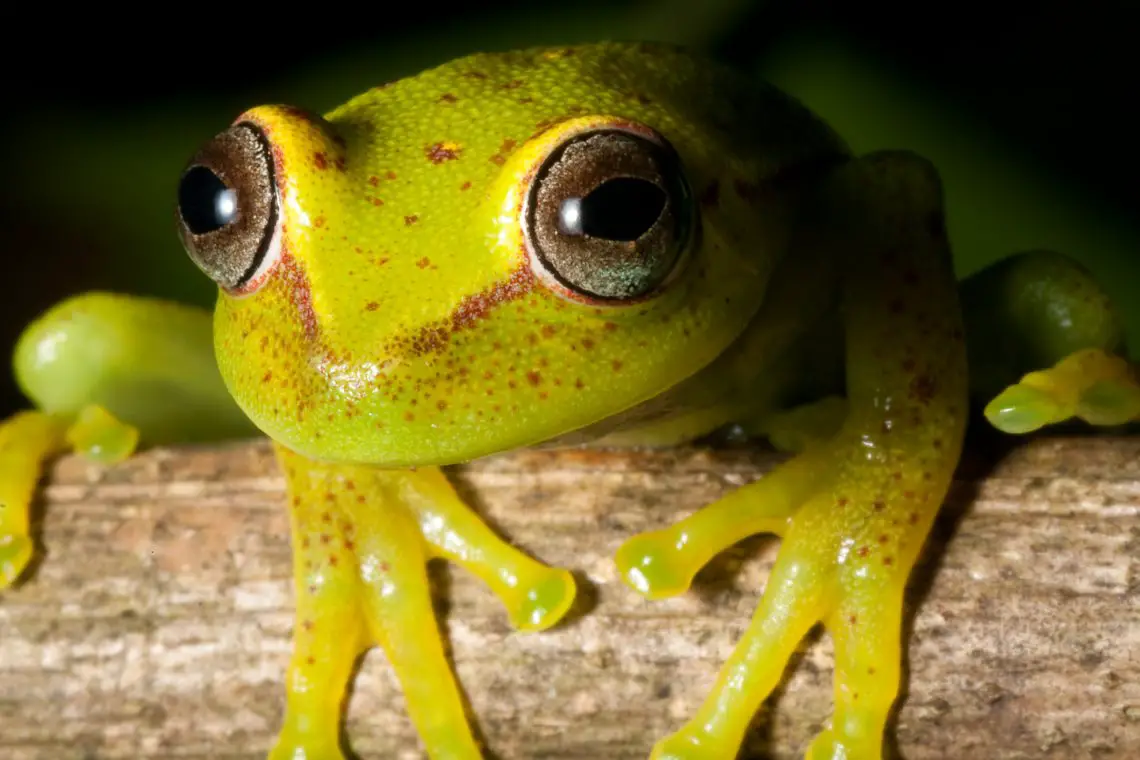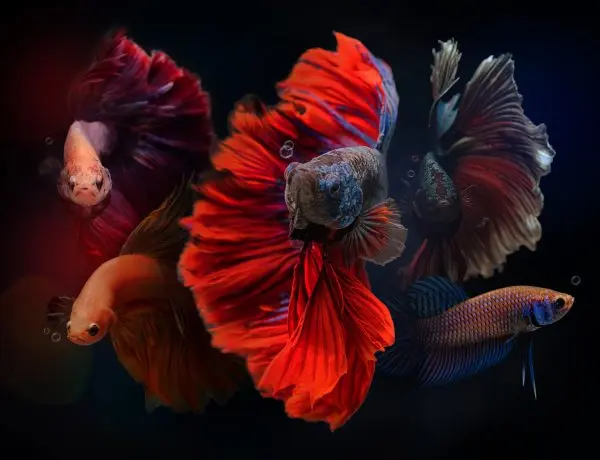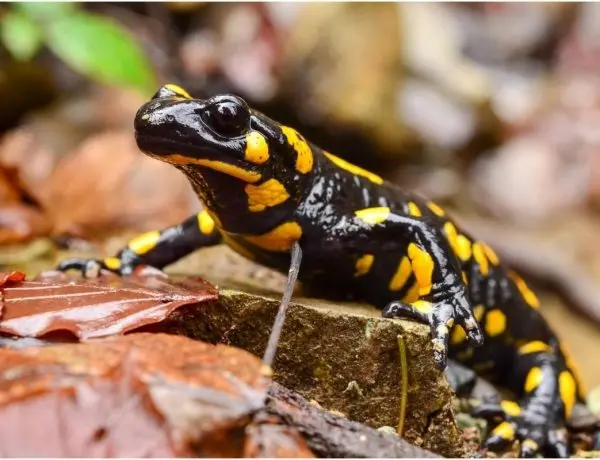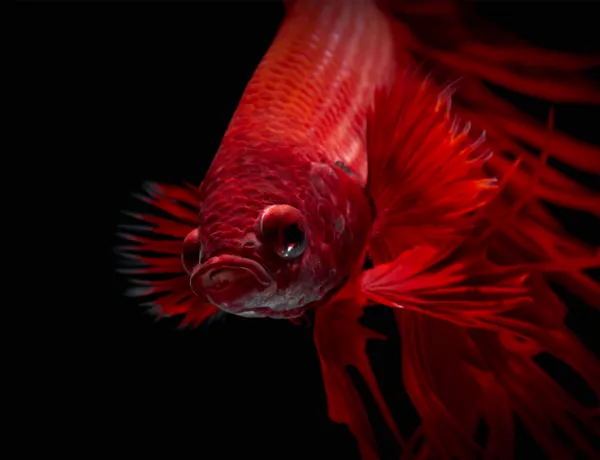There are a variety of amphibians that people choose to keep as pets. While some of them are safe to have as a pet, others may have characteristics or elements that need to be kept in mind. But, first off, what exactly is an amphibian? They are cold-blooded vertebrates and are characterized by their aquatic gill-breathing larval stage, which will then turn into a terrestrial lung-breathing stage when they reach adulthood.
The best amphibians to have as pets generally include frogs, toads, and salamanders. There are other types of amphibians, like newts, that can also be kept as pets but require more upkeep. Amphibians ordinarily are very low maintenance, once you understand their needs.
What types of amphibians do people keep as pets? While there are many different types of amphibians, some are safer to care for and keep than others. Typically, amphibians that are considered good ones to keep as pets are:
- Pacman Frogs
- White’s Treefrogs
- Tomato Frogs
- African Clawed Frogs
- Green Treefrogs
- African Dwarf Frogs
- Pixie Frogs
- Grey Tree Frogs
- Poison-dart Frogs
- Vietnamese Mossy Frogs
- Oriental Fire-bellied Toads
- Red Belly Toads
- North American Toads
- Axolotl
- Tiger Salamanders
- Spotted Salamanders
Check out our list of different amphibians below, to find out if they’re beginner-friendly or not. Along with information on their size, lifespan, types of habitat, diet, and more!
Table of Contents
1. Pacman Frog
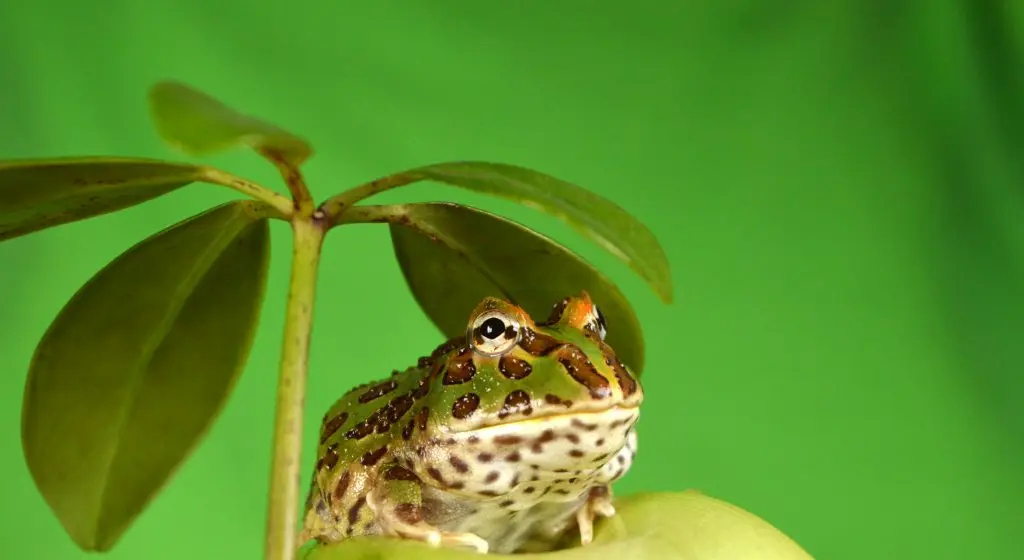
Beginner Friendly? Yes
Size: Male 2.5-4 inches; Female 4-7 inches
Lifespan: Up to 15 years
Type of Habitat: 10- to 20-gallon tank, shallow water bowl, and a substrate that retains moisture
Temperature/Humidity Level: 74-82F, 50-80% Humidity
Diet: crickets, earthworms, minnows, guppies, and mice
Pacman frogs are safe to handle. Be sure to wash your hands before and after handling them as they tend to absorb things through their skin. They like to burrow, so be sure to have plenty of substrates available.
2. White’s Tree Frog
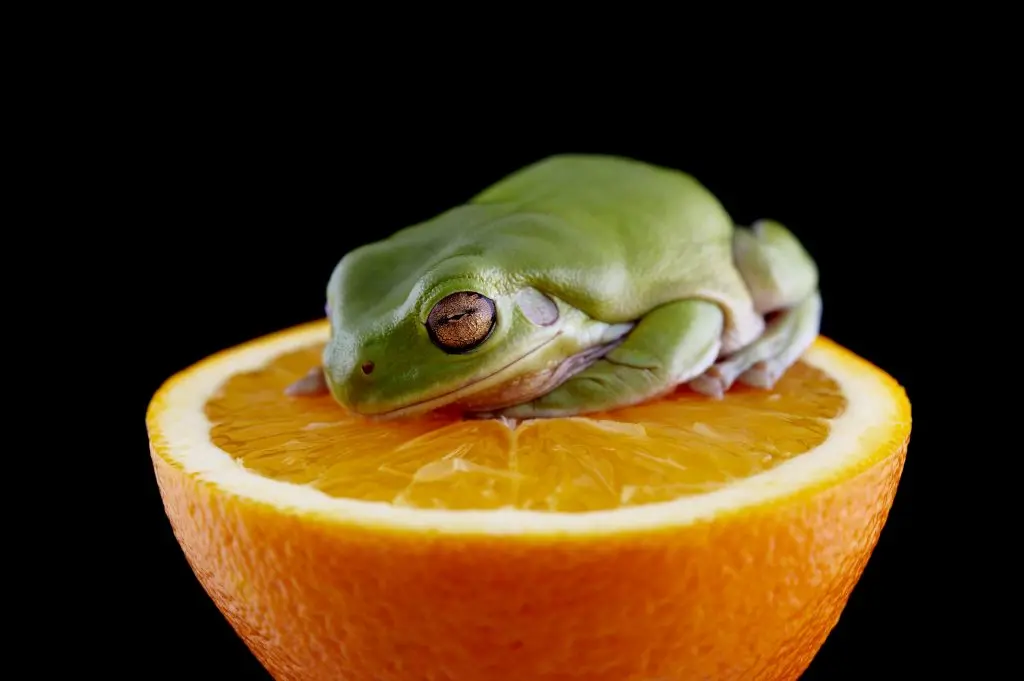
Beginner Friendly? Yes
Size: Up to 4.5 inches
Lifespan: Up to 21 years
Type of Habitat: 20-gallon aquarium during adolescence, tall terrarium during adulthood, branches, safe and moist substrate, small pond area
Temperature/Humidity Level: 70-80F, 60-90% Humidity
Diet: earthworms, crickets, nightcrawlers, and small mice
As one of the more hardy of frogs, the White’s treefrog is a top choice for most beginners. While they may not be as colorful as the better-known red-eyed treefrog, they do have the ability to change colors slightly. Unlike most other frogs, White’s treefrogs do very well with being handled. But, remember to always wash your hands before and after handling!
3. Tomato Frog
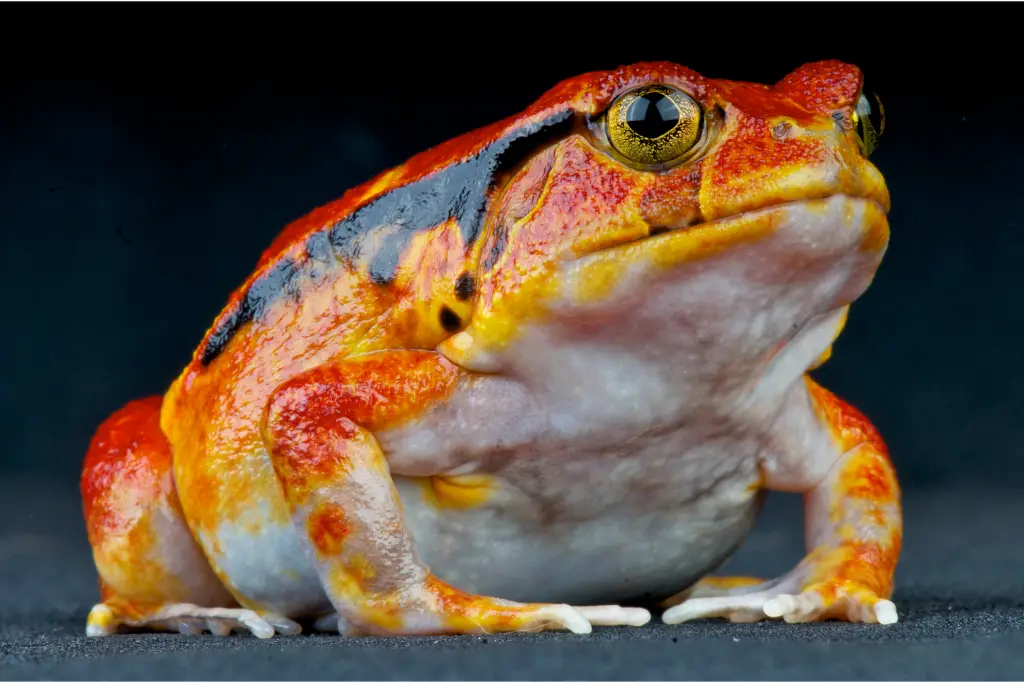
Beginner Friendly? Yes
Size: Up to 4 inches
Lifespan: Up to 8 years
Type of Habitat: at least a 10-gallon tank, a substrate that retains moisture, and a shallow water dish
Temperature/Humidity Level: 64-80F, 50-70% Humidity
Diet: crickets, earthworms, and small mice
The Tomato frog is typically a nocturnal amphibian, and you should mist them daily. While they are not poisonous, they do secrete toxins when they get scared that may cause an allergic reaction on your skin. Tomato frogs are named for their bright “tomato-like” colors and are known to be friendly and docile pets.
4. African Clawed Frog
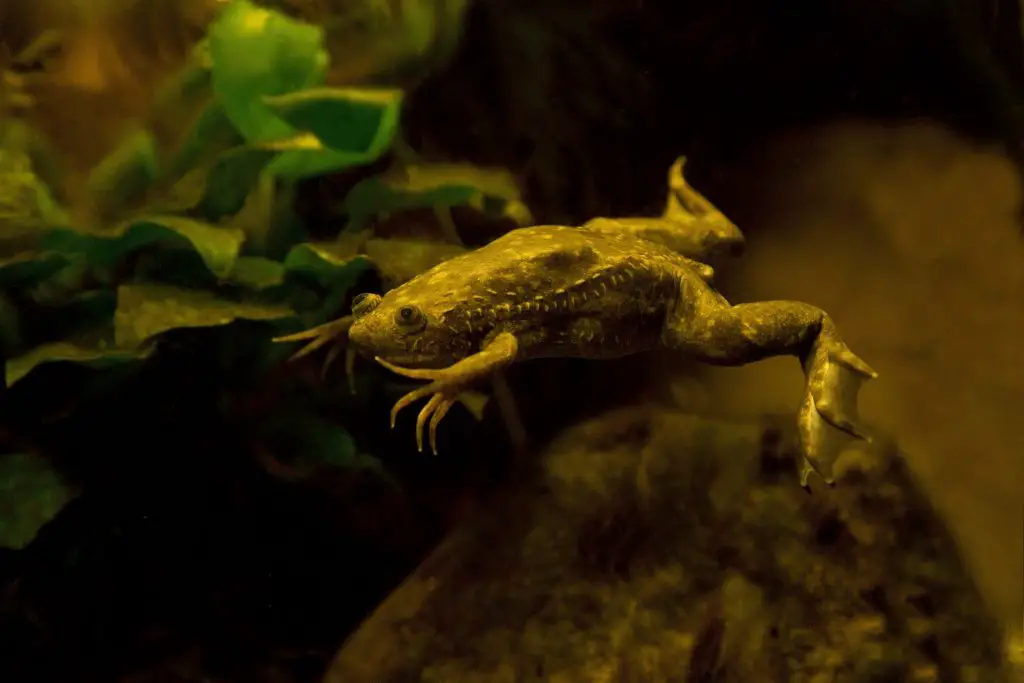
Beginner Friendly? Yes
Size: Up to 5 inches
Lifespan: Up to 25 years
Type of Habitat: 10-gallon aquarium
Temperature/pH Level: 72-80F, 7-7.8 pH
Diet: amphibian sticks, waxworms, earthworms, feeder fish, bloodworms, and brine shrimp
African clawed frogs can be distinguished from the others because of their webbed back feet and short front arms. They can live up to 25 years, but the average lifespan is typically around 10-15 years.
5. Green Tree Frog
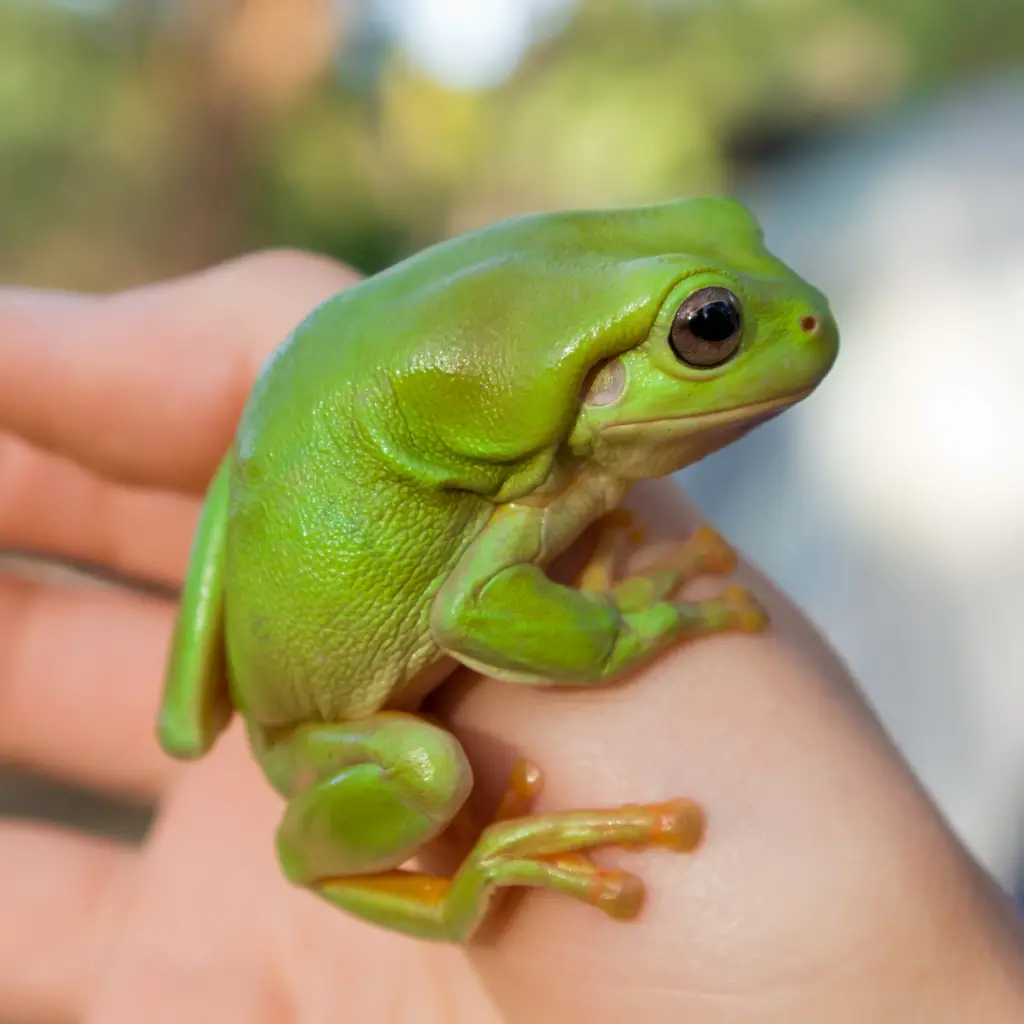
Beginner Friendly? Intermediate
Size: Up to 2 inches
Lifespan: Up to 16 years
Type of Habitat: A Vertical Terrarium, branches, large shallow water dish, non-particulate substrate, and a heat lamp
Temperature/Humidity Level: 70-80F, at least 50% Humidity
Diet: gut-loaded crickets, worms, roaches, and moths
While it is quite common to find green tree frogs in the wild, frogs raised in captivity are the best to keep as pets. Wild-caught frogs have difficulty adjusting to a captive lifestyle, and it is more difficult to determine their health and age. Green tree frogs have very delicate skin, so handling them should be kept to a minimum.
6. African Dwarf Frog
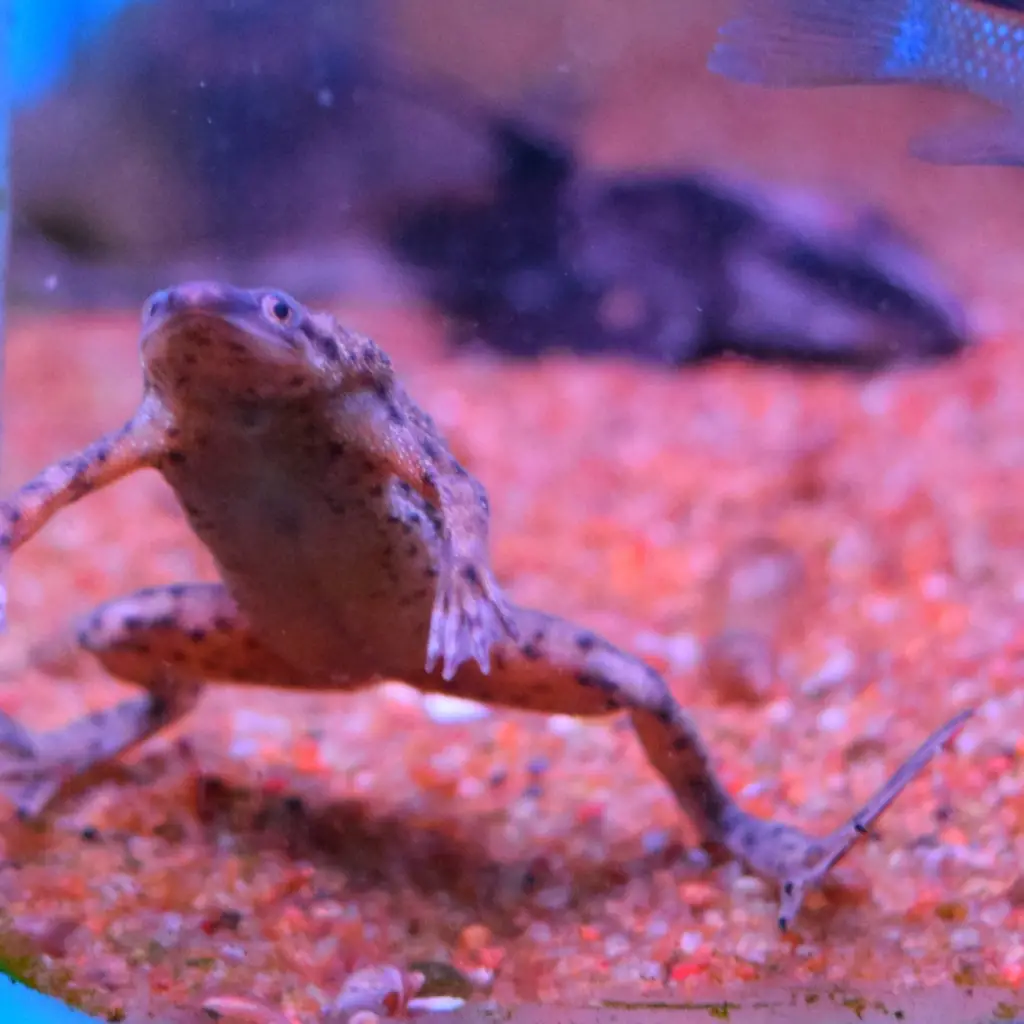
Beginner Friendly? Yes
Size: Up to 3 inches
Lifespan: Up to 15 years
Type of Habitat: 10-gallon aquarium (no more than 12″ tall)
Temperature/pH Level: 75-82F, 6.5-7.5 pH
Diet: brine shrimp, bloodworms, commercial frog food, krill, small pieces of worms, and small live fish
African Dwarf Frogs tend to be pretty social creatures, so they enjoy being in groups of at least two or more. They are fully aquatic and will dry out if they are out of the water for over 20 minutes.
7. Pixie Frog
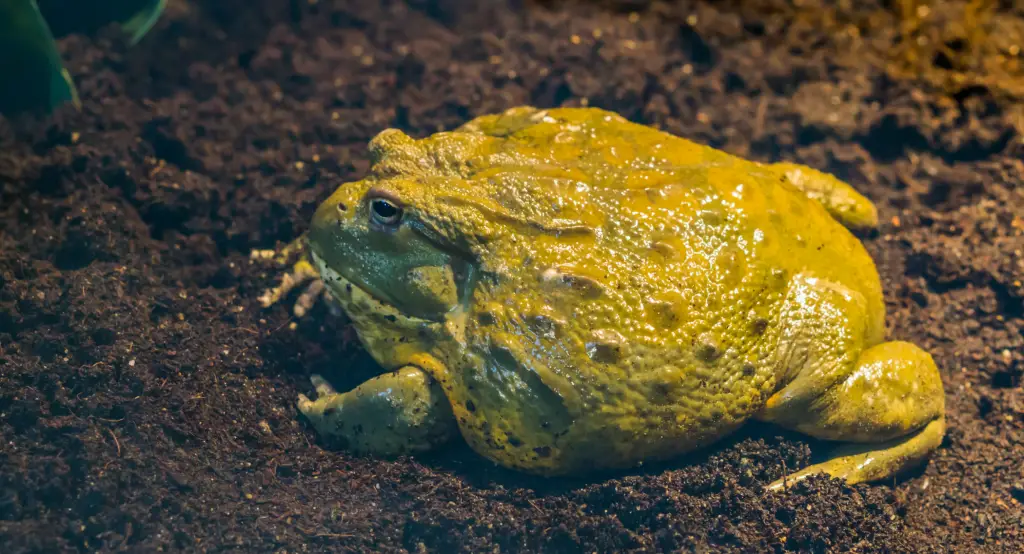
Beginner Friendly? Yes
Size: 4-10 inches
Lifespan: Up to 25 years
Type of Habitat: a 10-gallon terrarium, moisture-retaining substrate, and a shallow water dish
Temperature: 75-90F
Diet: crickets, earthworms, hornworms, silkworms, and thawed frozen rodents
Pixie frogs tend to be slightly larger than the other frogs and weigh more as well. They do best when not handled too often due to getting stressed out when taken from their environments. Pixie frogs have huge mouths and will try to eat just about anything.
8. Gray Tree Frog
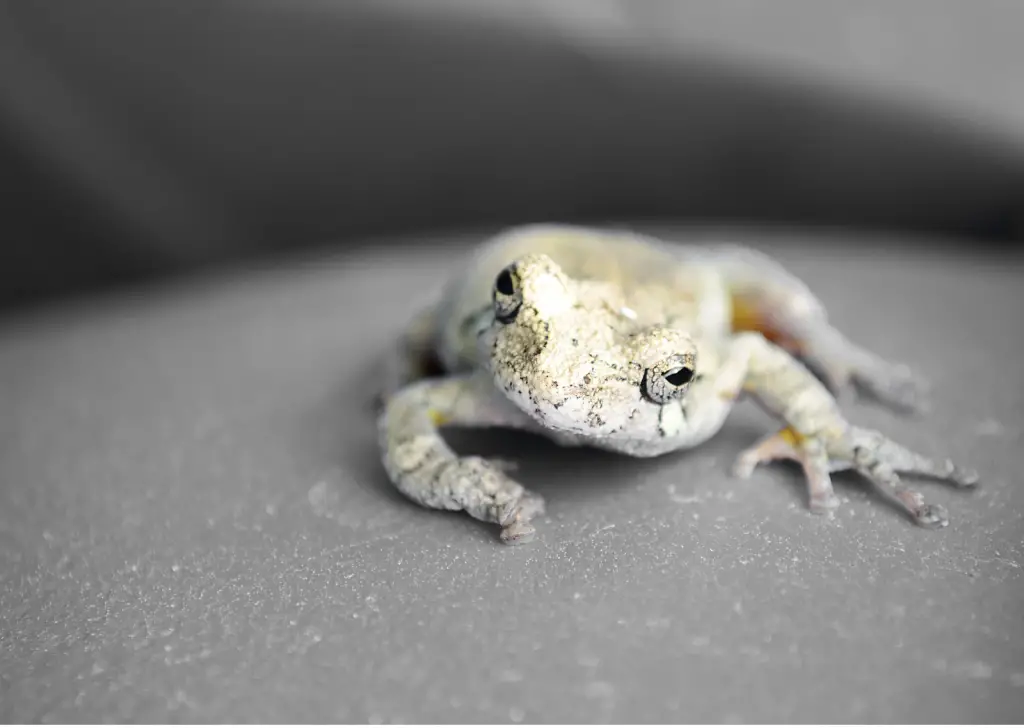
Beginner Friendly? Yes
Size: 1.5-2 inches
Lifespan: Up to 10 years
Type of Habitat: 300mm by 450mm vivariums, with plants or sticks to climb on.
Temperature/Humidity Level: 75-80F, 50% Humidity
Diet: spiders, mites, plant lice, snails, slugs, and tadpoles
Like many types of frogs, the gray tree frog secretes a mild toxin on their skin. If handling them, it is best to wash your hands before as well as afterward. Just like their name suggests, they love to climb on trees. So, they will be much happier when they have ample space to jump and climb.
9. Poison-dart Frog
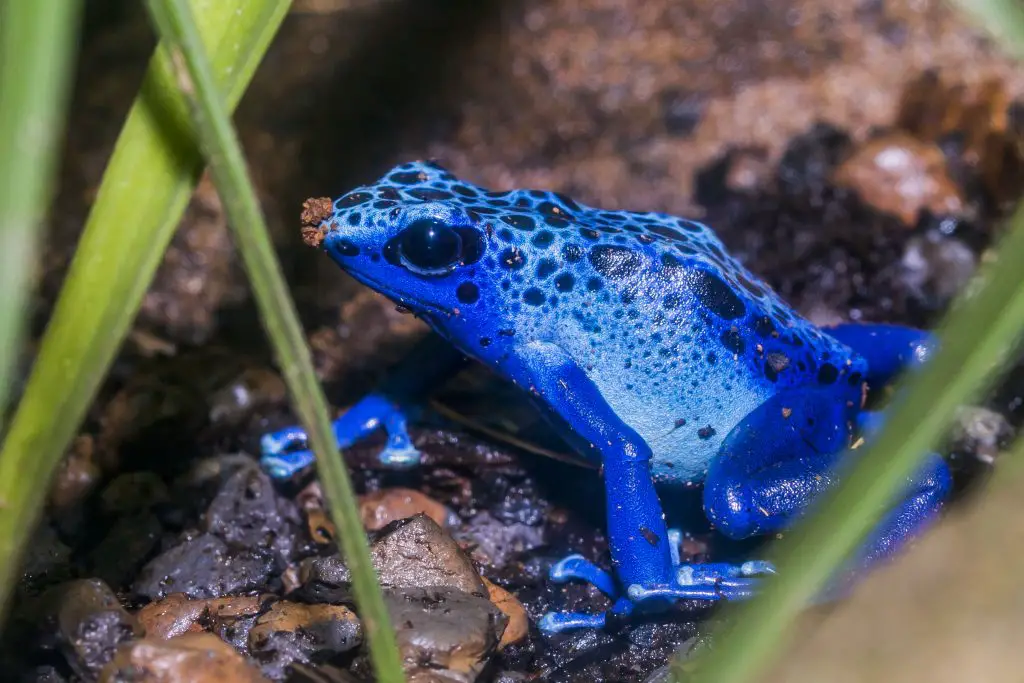
Beginner Friendly? Intermediate-Expert
Size: Up to 2.4 inches
Lifespan: Up to 8 years
Type of Habitat: a 20-gallon aquarium, hinged glass cover, cork bark, drainage substrate, driftwood, and plants
Temperature/Humidity Level: 72-80F, 80% Humidity and above
Diet: flightless fruit flies and pinhead crickets
Poison-dart frogs are best suited for those with experience keeping amphibians. Setting up their habitat takes a bit more time, and the humidity level should never drop below 80% (the higher, the better!). As long as your poison-dart frog does not consume anything containing alkaline, they do not become poisonous. Due to size and the general fragility, they should still not be handled often.
10. Vietnamese Mossy Frog
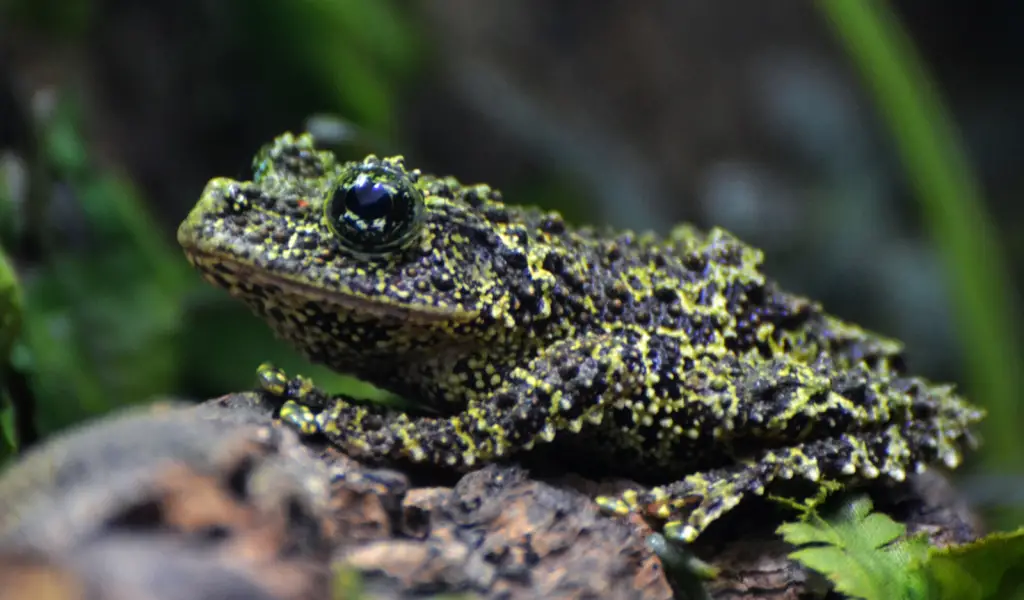
Beginner Friendly? Expert
Size: Up to 3.5 inches
Lifespan: Up to 20 years
Type of Habitat: a 20-gallon aquarium with full water bottom, floating cork-bark flats, plants, and live fish
Temperature/Humidity Level: 68-74F, 70-90% Humidity
Diet: crickets, cockroaches, and earthworms
These fun looking frogs have bumpy green skin and large round eyes. Vietnamese Mossy Frogs are not always best for beginners because setting up their habitats tends to be more complicated and require extra upkeep than other amphibian habitats. When they are scared, they will curl up into a ball and play dead.
11. Oriental Fire-bellied Toad
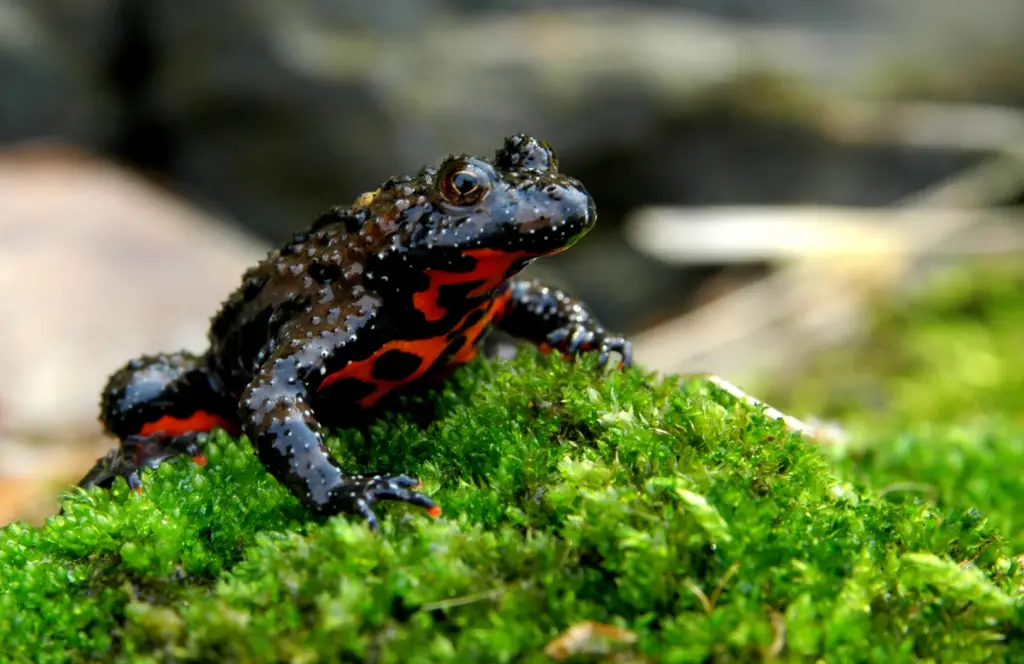
Beginner Friendly? Yes
Size: Up to 2 inches
Lifespan: Up to 15 years
Type of Habitat: a humid and moist glass terrarium
Temperature/Humidity Level: High 80sF, 60-70% Humidity
Diet: worms, mollusks, and insects
The oriental fire-bellied toad is quite neat to look at and are great display amphibians. They are not a frog to be handled, as they secrete a toxin that may cause skin irritation depending on how sensitive your skin is. They also do best alone and not mixed with other types of frogs.
12. Red-belly Toad
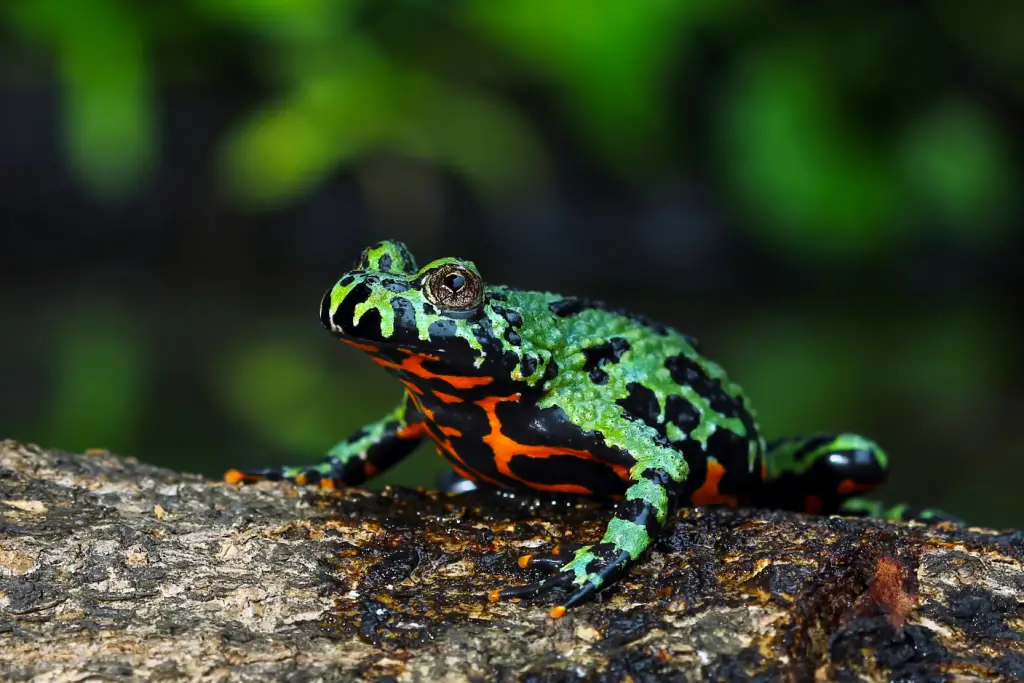
Beginner Friendly? Yes
Size: Male up to 1 inch, Female up to 1.5 inches
Lifespan: Up to 10 years
Type of Habitat: A 10-gallon terrarium can be used for between 3-6 red-belly toads. You should have a coconut fiber substrate, plants, reptile hides, and a shallow water dish.
Temperature/Humidity Level: 65-75F, 50-60% Humidity
Diet: fruit flies, springtails, and pinhead crickets
Commonly referred to as bumble bee toads, the red-belly toad often gets confused with the oriental fire-bellied toad. They are known for their red bellies and feet. While they can be handled, it is best only to handle them during tank maintenance because they get stressed out quite easily. For a happier toad, use reptile hides in their habitat to help them feel safe.
13. North American Toad
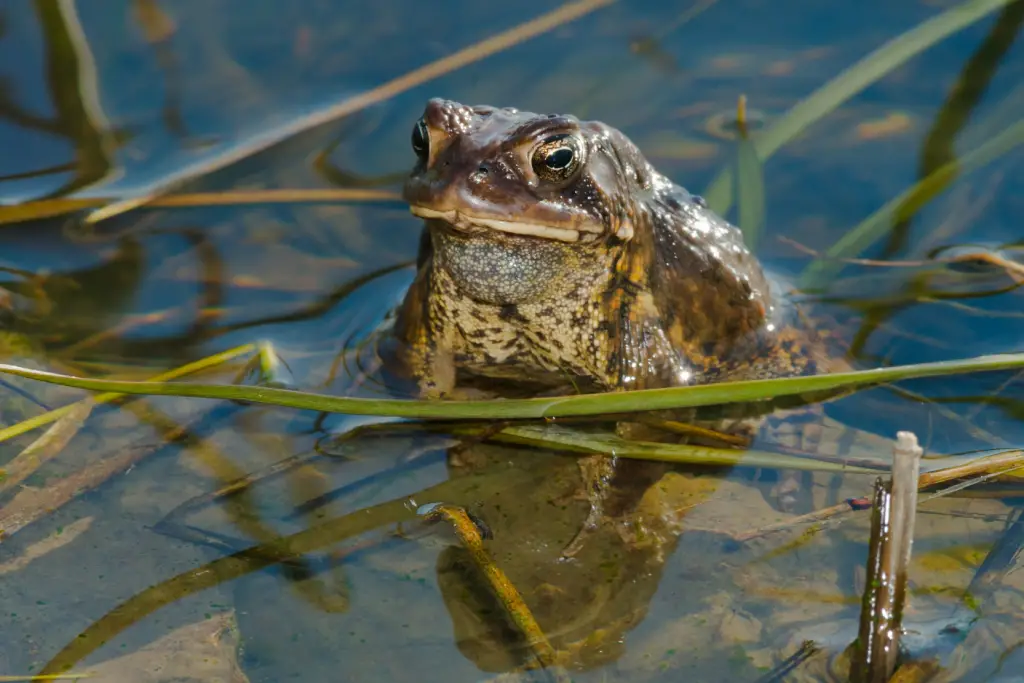
Beginner Friendly? Yes
Size: Up to 4 inches
Lifespan: 8-12 years
Type of Habitat: at least a 15-gallon aquarium with a secure screen cover, a moisture-retaining substrate, some reptile hides, plants, and a shallow water dish
Temperature/Humidity Level: 60-75F, varied humidity
Diet: crickets, wax worms, mealworms, and earthworms
North American toads come in several different varieties depending on the location. They do not typically enjoy hot weather, so the best temperature for them is low to mid-70s. They can also tolerate different humidity levels. So misting them several times a week and providing a water dish for them to soak in, should be adequate.
14. Axolotl
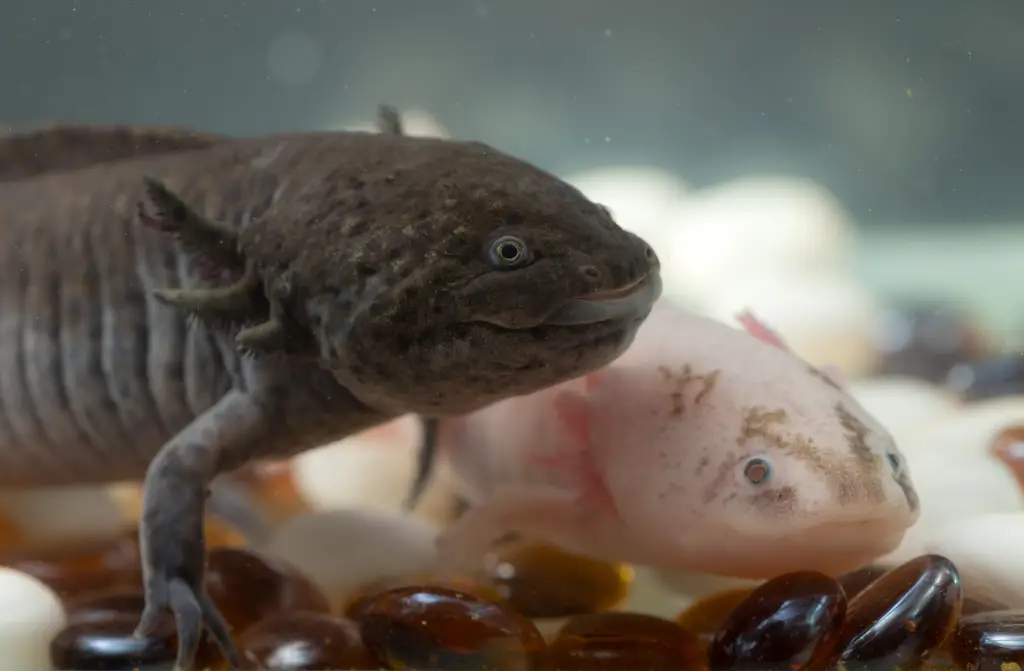
Beginner Friendly? Yes
Size: 7-12 inches
Lifespan: Up to 20 years
Type of Habitat: at least 10-gallon aquarium (bigger is better!)
Temperature/pH Level: 56-72F, around 7.2 pH
Diet: They prefer to eat live chopped earthworms, blackworms, brine shrimp, and daphnia.
The Axolotl is one of few amphibians that does not need to go through a metamorphosis stage to reach adulthood. It stays in the water and does best when it has more space to swim around. The Axolotl is related to the tiger salamander, but they live in water, unlike their striped cousin. Their bodies are mostly cartilage and very delicate, so they shouldn’t be handled unless it is extremely necessary.
15. Tiger Salamander
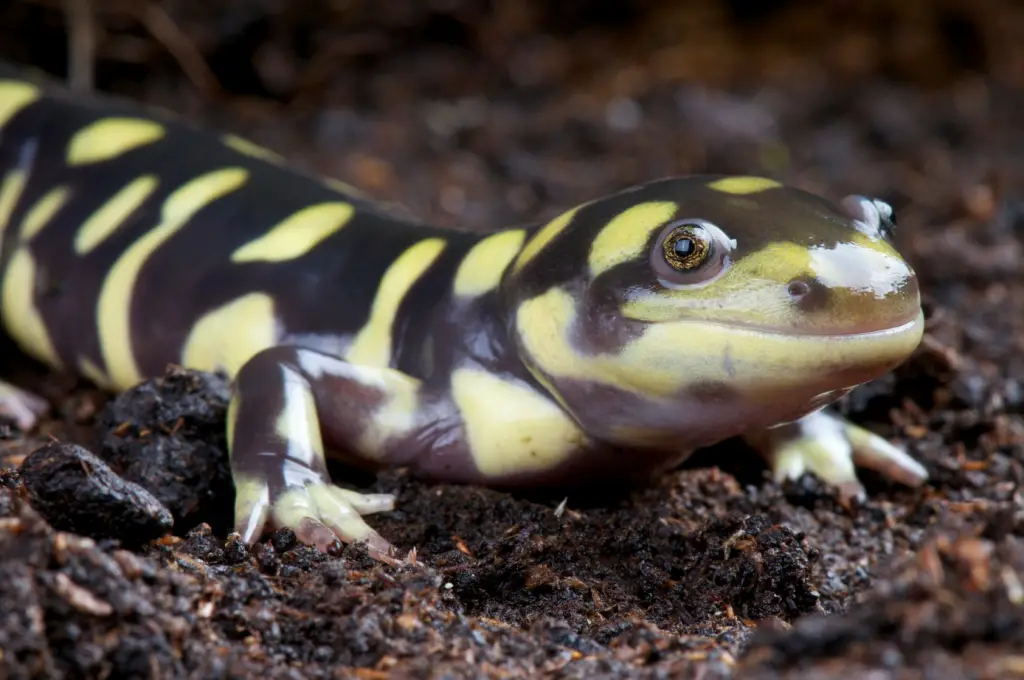
Beginner Friendly? Yes
Size: Up to 14 inches
Lifespan: Up to 25 years
Type of Habitat: semi-aquatic 20-gallon tank (their larval stage requires an entire aquatic tank)
Temperature: 65-70F
Diet: invertebrates (daphnia, brine shrimp, insects, small fish, worms)
One of the largest salamanders that live on land, the tiger salamander, is usually up at night, hunting its prey or burrowing into the ground. While most salamanders are standoffish and unable to warm up to their owners, the tiger salamander does well and will follow you around from inside their tank. They can be handled, but have sensitive skin so handling them shouldn’t be done often, and should also be done carefully.
16. Spotted Salamander
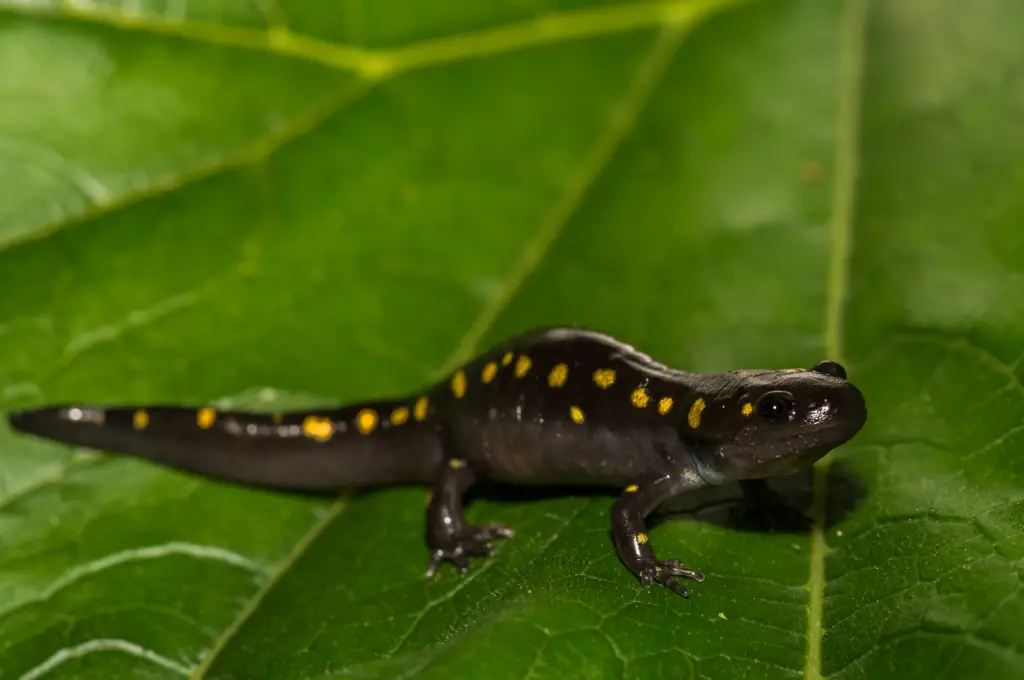
Beginner Friendly? Yes
Size: Up to 9 inches
Lifespan: Up to 20 years
Type of Habitat: s semi-aquatic 10 to 20-gallon tank, with a moisture-retaining substrate, plants, shallow water dish, and a few puddles
Temperature: 50-70F
Diet: crickets, chopped nightcrawlers, red wigglers, and small roaches
Pet spotted salamanders are usually caught in the wild because it is generally challenging to find someone selling them. They enjoy attention from their owners and are generally very easy to handle. Be careful not to scare your salamander as they will secrete a toxin from their back and tail that can cause skin irritation. It’s always best to wash your hands before and after handling your salamander.
Why Do Amphibians Make Great Pets?
While they are not as cuddly as dogs and cats, amphibians are great pets for those that enjoy observing their daily activity and feeding habits. They also come in so many different colors, sizes, and sometimes even shapes that aesthetically they make a great addition to any home.
Most amphibians have pretty mild temperaments, but they do scare and stress easily, so it is best to keep from handling them too much. Many frogs and toads like to “talk” so they may spend the night ribbiting away.
Another opportunity that owning amphibians bring is an educational experience. If you have kids or just want to learn more about an amphibians lifestyle, their low maintenance setup makes them an ideal choice for a pet.
Most amphibians do not require an extravagant maintenance routine and are usually pretty easy to take care of. While they shouldn’t be handled often, some amphibians can be held. Certain amphibians will build a bond with their owners and will show interest when their owners come near their habitat.
What Preparations Should I Make When Getting an Amphibian?
Before purchasing your amphibian, it’s best to learn about the species you’re thinking about getting. You should also spend time to learn about what type of habitat they dwell in and to set up their home beforehand, so they have a place when they arrive.
The top items to have for most amphibians include:
- Terrarium or aquarium
- Water source (shallow dish or full water depending on the amphibian)
- Plants, branches
- Safe substrate
- Humidity device
- Lighting
- Heat source
Each amphibian may require slight adjustments and modifications in their setup, so be sure to check the requirements for your amphibian before bringing them home.
Depending on where you live, there might be different amphibians available in local pet shops. Be sure to check if the amphibian you want can survive in your area and how difficult it is to transport them to your home.
General Amphibian Care Tips
Amphibians can be a rewarding pet to have as you watch them happily enjoy their new home. Be careful about handling them too much or not paying them enough attention to them. Most amphibians have very delicate skin or do not like to be handled much. At the same time, others may enjoy a decent amount of social interaction.
It is also best to check if it’s better to have one amphibian per habit setup or if they do better with friends. Most amphibians should be kept separated from different species or even color variations (like the poison-dart frog) because they may not all get along.
Whether it’s a frog, toad, or a salamander, amphibians don’t drink water. Depending on the type of amphibian you have, they will either sit and absorb water in a dish or require a high humidity level and absorb it from the air.
Some frog species are considered to be arboreal; they spend the majority of their lives in trees. Even if you don’t have a full forest for them to jump around in, they will do well with vertical cages that have plenty of branches for them to jump around on.
Many amphibians go through a metamorphosis stage, meaning they transform from an egg, larva, and then finally an adult. Metamorphosis periods are different for each amphibian, but they may require different setups for each stage.
Amphibian Care provides a plethora of care sheets for a variety of amphibians on their website. Each sheet includes in-depth information on the amphibian from behavior to setup.
Note: Amphibians have very absorbent skin and will absorb whatever is on your hands. Even after washing your hands, they tend to absorb the salt and oil off your skin, so it is best to limit most amphibians’ handling.
The best way to tell if your amphibian is doing well is to check that they are regularly eating, have no sudden changes in their weight, and they have healthy eyes and skin.
If your amphibian has experienced the following symptoms, be sure to contact your exotic animal vet:
- Diarrhea
- Labored breathing
- Weight loss
- Dull or cloudy eyes
- Poor balance
- Unusual bloating
- Skin lesions
- Parasites on their skin
Next Steps
So, before you go out and get your next pet amphibian, make sure to check out the requirements for them to have a happy home. Like other animals, Amphibians have quite the range in personalities and behaviors, so depending on the type you get, they may be laid back or very active.
The top 16 amphibians that we mentioned include various frogs, toads, and salamanders. Each has a unique size, lifespan, and habitat setup.
Remember: Most amphibians will require at least five years of commitment. Depending on the species, they may live to be almost 30 years old!
Researching the amphibian that you want and asking specialists (such as pet stores and breeders) will help in your decision of which amphibian to get. Again, amphibians are a joy to have and fun to watch, so be prepared to watch your new friend’s personality bloom.

